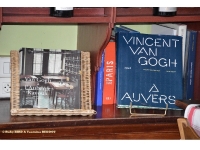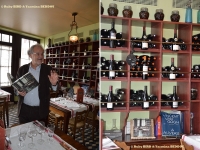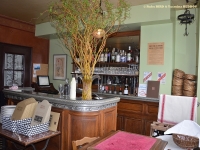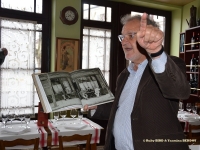Arts
AUBERGE RAVOUX (Ravoux Inn) called the House of VAN GOGH
The INN & The BEDROOM
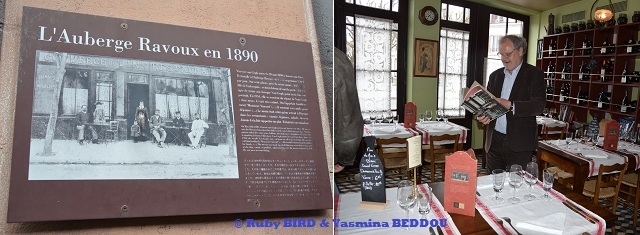
The RAVOUX INN - (R) Dominique Charles JANSSENS (Source: © Ruby BIRD & Yasmina BEDDOU)
USPA NEWS -
Vincent Van Gogh was a Dutch Post-Impressionist painter who is among the most famous & influential figures in the History of Western art. In just over a decade he created about 2,100 artworks, including around 860 Oil Paintings, most of them in the last two years of his life in France, where he died
Vincent Van Gogh was a Dutch Post-Impressionist painter who is among the most famous & influential figures in the History of Western art. In just over a decade he created about 2,100 artworks, including around 860 Oil Paintings, most of them in the last two years of his life in France, where he died. They include landscapes, still lifes, portraits and self-portraits, and are characterised by bold colours and dramatic, impulsive and expressive brushwork that contributed to the foundations of Modern Art. His suicide at 37 followed years of mental illness and poverty.
He drifted in ill health and solitude before taking up painting in 1881, having moved back home with his parents. His younger brother Theo Van Gogh supported him financially, and the two kept up a long correspondence by letter. In 1886 he moved to Paris, where he met members of the avant-garde, including Émile Bernard & Paul Gauguin, who were reacting against the Impressionist sensibility. Vincent Van Gogh suffered from psychotic episodes and delusions and though he worried about his mental stability, he often neglected his physical health, did not eat properly and drank heavily. His friendship with Gauguin ended after a confrontation with a razor, when in a rage, he severed part of his own left ear. He spent time in psychiatric hospitals.
After he discharged himself and moved to the Auberge Ravoux in Auvers-sur-Oise near Paris, he came under the care of the homeopathic doctor Paul Gachet. His depression continued and on 27 July 1890, Van Gogh shot himself in the chest with a revolver. He died from his injuries two days later. Vincent Van Gogh was unsuccessful during his lifetime, and was considered a madman and a failure. He became famous after his suicide, and exists in the public imagination as the quintessential misunderstood genius.
The most comprehensive primary source on Vincent Van Gogh is the correspondence between him and his younger brother, Theo Van Gogh (an art dealer providing his brother with financial and emotional support, and access to influential people on the contemporary art scene). Their lifelong friendship, and most of what is known of Vincent's thoughts and theories of art, are recorded in the hundreds of letters they exchanged.
Ill from drink and suffering from smoker's cough, in February 1888 Van Gogh sought refuge in Arles. The time in Arles became one of Vincent Van Gogh's more prolific periods: he completed 200 paintings, and more than 100 drawings and watercolours. He was enchanted by the local landscape and light ; his works from this period are rich in yellow, ultramarine and mauve. In May 1890, Vincent Van Gogh left the Clinic in Saint-Rémy to move nearer to both Dr Paul Gachet in Auvers-sur-Oise and to his brother Theo. Dr Paul Gachet was an Amateur Painter and had treated several other Artists.
The painter Charles-François Daubigny moved to Auvers in 1861, and in turn drew other aAtists there, including Camille Corot, Honoré Daumier, Oudinot... In July 1890, Vincent Van Gogh completed two Paintings of Daubigny's Garden, one of which is likely his final work. On 27 July 1890, aged 37, he shot himself in the chest with a revolver. There were no witnesses and he was able to walk back to the Auberge Ravoux where he died 30 hours after the incident.
The doctors tended to him as best they could, the following morning Theo rushed to his brother's side. Van Gogh was buried on 30 July, in the municipal cemetery of Auvers-sur-Oise. The funeral was attended by Theo van Gogh, Andries Bonger, Charles Laval, Lucien Pissarro, Émile Bernard, Julien Tanguy and Paul Gachet, among twenty family, friends and locals. Theo Van Gogh had been ill, and his health began to decline further after his brother's death. Weak and unable to come to terms with Vincent's absence, he died on 25 January 1891 at Den Dolder, and was buried in Utrecht. In 1914, Johanna van Gogh-Bonger had Theo's body exhumed and moved from Utrecht to be re-buried alongside Vincent's at Auvers-sur-Oise.
Vincent Van Gogh's works are among the world's most expensive Paintings. Those sold for over US$100 million (today's equivalent) include 'Portrait of Dr Gachet', 'Portrait of Joseph Roulin' and 'Irises'. The Van Gogh Museum opened in the Museumplein in Amsterdam in 1973. It became the second most popular Museum in the Netherlands (85 % of the visitors come from other countries).
* The RAVOUX INN
The Ravoux Inn was at first a wine merchant´s business as well as a restaurant when it opened in 1876, and it has kept its décor and typical late Nineteenth Century Atmosphere. Soon, the Café attracted customers and became a good gathering place for Artists. This was the time when young Painters travelled to Auvers-Sur-Oise by train to seek advice and guidance from the Masters of Impressionism: Camille Pissarro lived nearby in Pontoise and Honoré Daumier was in the neighboring village of Valmondois. Charles-François Daubigny was in Auvers-Sur-Oise itself, and Paul Cézanne had worked here for two years.
The Ravoux Inn was at first a wine merchant´s business as well as a restaurant when it opened in 1876, and it has kept its décor and typical late Nineteenth Century Atmosphere. Soon, the Café attracted customers and became a good gathering place for Artists. This was the time when young Painters travelled to Auvers-Sur-Oise by train to seek advice and guidance from the Masters of Impressionism: Camille Pissarro lived nearby in Pontoise and Honoré Daumier was in the neighboring village of Valmondois. Charles-François Daubigny was in Auvers-Sur-Oise itself, and Paul Cézanne had worked here for two years.
There were four rooms on the first floor and three on the second, alongside the attic. The rooms were furnished in only a rudimentary way : a bed, a chair, a little bedside cabinet, or a cupboard for keeping one´s things in. in 1890, a Dutch painter called Vincent Van Gogh intended to stay in Auvers for a while, and to visit a Doctor by the name of Gachet who had been recommended to Theo van Gogh by Camille Pissarro....
* VINCENT VAN GOGH BEDROOM
Ravoux had a little room on the second-floor landing available, lit by a skylight let into the roof. It cost only 1 franc per day, and meals would be 2.50 francs on top. The Inn was only one of ten or so in Auvers-Sur-Oise at the time. That very same springtime another Dutch Painter, Anton Hirschig, moved into an adjacent room on the second floor. It was possibly Theo van Gogh who had given him Vincent´s address. In 1890, Vincent Van Gogh shot himself in the wheatfields behind the park of the Château of Léry and staggered back to the Inn.
Ravoux had a little room on the second-floor landing available, lit by a skylight let into the roof. It cost only 1 franc per day, and meals would be 2.50 francs on top. The Inn was only one of ten or so in Auvers-Sur-Oise at the time. That very same springtime another Dutch Painter, Anton Hirschig, moved into an adjacent room on the second floor. It was possibly Theo van Gogh who had given him Vincent´s address. In 1890, Vincent Van Gogh shot himself in the wheatfields behind the park of the Château of Léry and staggered back to the Inn.
Theo Van Gogh received a message from Dr. Gachet let for him by Anton Hirschig at the Boussod & Valadon gallery. He left immediately and arrived at the Inn around midday. The two brothers spent their last, long evening together deep in conversation. Theo hoped against hope that his brother would pull through. But Vincent´s view was : 'Sadness goes on forever' and died at the age of 37. In the morning, Arthur Ravoux went with Theo to the Mairie to deal with the official registration of the death. After the burial, Theo suggested to Vincent´s friends that they could keep a painting or two to remember him by.
* From the RAVOUX's Ownership to Dominique Charles JANSSENS (Belgian Businessman)
After the Liberation of France in 1945 the Ravoux Inn changed hands several times in a few years. The building was in a poor state of repair and the establishment´s reputation suffered. in 1952, Roger and Micheline Tagliana took over. Adeline Ravoux came back to visit her former home in 1954, and it was with her help that Vincent´s room was put back together as it had been. It was soon getting regular visits from his devotees. Intellectuals like André Malraux also began to enjoy the lively atmosphere that prevailed in the “˜House of Van Gogh´, as did artists such as Zadkine, Poliakoff and Pignon. Exhibitions were organized...
After the Liberation of France in 1945 the Ravoux Inn changed hands several times in a few years. The building was in a poor state of repair and the establishment´s reputation suffered. in 1952, Roger and Micheline Tagliana took over. Adeline Ravoux came back to visit her former home in 1954, and it was with her help that Vincent´s room was put back together as it had been. It was soon getting regular visits from his devotees. Intellectuals like André Malraux also began to enjoy the lively atmosphere that prevailed in the “˜House of Van Gogh´, as did artists such as Zadkine, Poliakoff and Pignon. Exhibitions were organized...
When the widowed Madame Tagliana decided to take her retirement, she began looking for a buyer for her Inn, which had been listed as a Historical Monument since 1985. Local authorities were not interested, but several other offers came in from businessmen, collectors and large companies. They all wanted to own the House of Van Gogh. She put her trust in the Restoration Project and Cultural Activities proposed by D.C. Janssens. These were based on maintaining the dual role of the Inn as an Artists´ Café and Cultural Center.
The building was more than 100 years old and in need of complete restoration. It took several years of planning before work at last began in January 1992. The whole building, from the cellar to the rooftops, every part of the structure including the walls, floors and ceilings had to be scanned, tested and reinforced. After more than a year of building work, the Ravoux Inn has been opening its doors since 17 September 1993 to all devotees of Vincent van Gogh.
Sources :
* Press Trip Auvers-Sur-Oise on March 23, 2017
* Testimony of Dominique Charles Janssens
Ruby BIRD
http://www.portfolio.uspa24.com/
Yasmina BEDDOU
http://www.yasmina-beddou.uspa24.com/
Sources :
* Press Trip Auvers-Sur-Oise on March 23, 2017
* Testimony of Dominique Charles Janssens
Ruby BIRD
http://www.portfolio.uspa24.com/
Yasmina BEDDOU
http://www.yasmina-beddou.uspa24.com/
Ruby Bird Yasmina Beddou Vincent Van Gogh Theo Van Gogh Auvers Sur Oise Dutch Post Impressionist Painter Western Art Oil Paintings
Liability for this article lies with the author, who also holds the copyright. Editorial content from USPA may be quoted on other websites as long as the quote comprises no more than 5% of the entire text, is marked as such and the source is named (via hyperlink).


